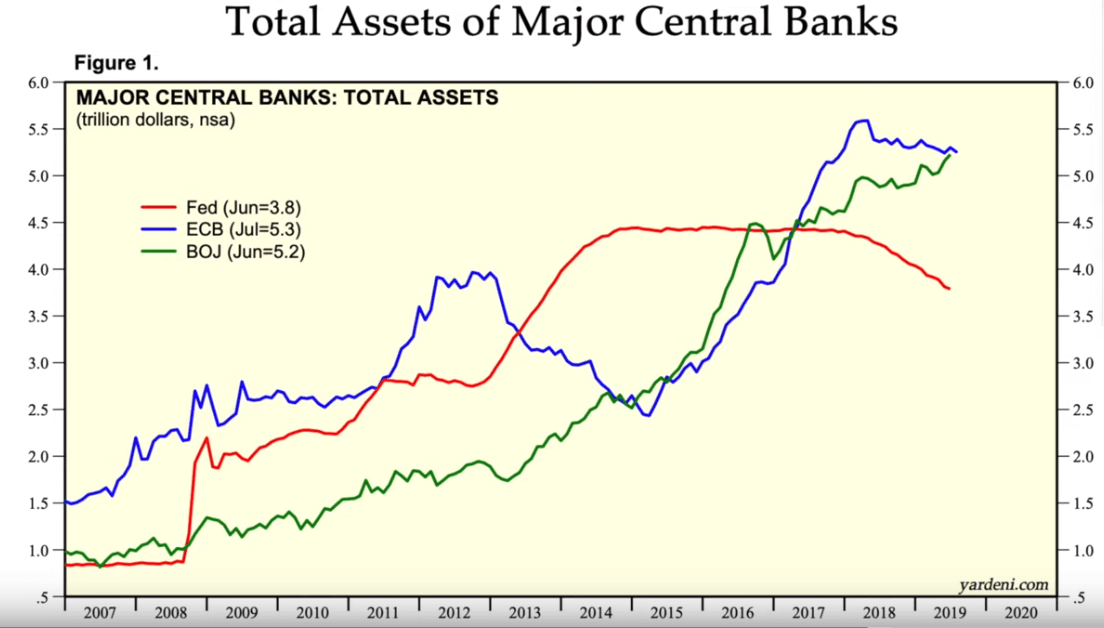This week, the US Federal Reserve announced that it is to cut interest rates by a quarter of a percentage point for the first time since 2008.
However, the impact on the stock markets was quite the opposite from what was expected.
Were investors and traders expecting a further cut? Or were there further hints regarding the Fed’s next move?
Fed cut rates by 0.25% as expected.
Stocks fell slightly.
Gold and oil down a bit.
Bitcoin followed selling lightly.— Mati (@MatiGreenspan) July 31, 2019
The Fed keeps releasing assets
One of the major indicators the Fed isn’t so bullish is that, despite the fact that interest rates will be 0.25% lower (for banks), its policy on decreasing assets keeps pushing the market as intended.
I personally thought its total assets would stabilise. However, the downtrend is still present, meaning the Fed is lowering the number of shares and bonds its holding.
Is this a sign of trouble or is it the light at the end of the tunnel?

As the stock markets have been in an uptrend since earlier this year and economic growth seems to be stagnating – despite the jobs statistics stating otherwise (another red flag) – I assumed the Fed’s position would be to hold on to its assets.
Interestingly, it’s choosing to do the opposite and let companies buy back their assets. In essence, this is bad news for the stocks.
Since January 2018, the Fed has decreased its total assets by about 14%. If the trend continues, we could see the number growing to over 25% by 2020, as the Fed could potentially reach 2013 lows around $3.2 trillion.
The broader spectrum
Unfortunately, doom and gloom is what seems to be coming.
With increasing quantitative easing in Europe and Japan, you would expect the broader markets to keep increasing in value.
But unlike the Fed, most other central banks are actually buying up assets and inflating the market.

Looking at the ECB (European Central Bank) and the BOJ (Bank of Japan), we can clearly see the uptrend (of money printing) is continuing. Both central banks have been printing money like crazy with constant quantitative easing since 2008.
The percentage of total assets held by central banks, as a percentage of local GDP, has also been spiking recently. The ECB currently holds about 40%, while the Fed holds about 18%. The scariest scenario is seen with the BOJ, which already holds 100% of Japan’s total assets when measured in GDP terms.
How much worse could it get?

If the above graph is anything to go by, things could be getting much worse. To clarify, here’s how the correlation plays out (according to me):
- Central banks create money and cheaply lend to banks, but also buy assets with some of said funds.
- Every time there’s quantitative easing (money printing), there’s a pump in the stock prices as well.
- Total assets increase along with the price of stocks (shown by the rising S&P500).
- When the trend reverses with quantitative tightening, a slight reversal in the total money supply trend will shatter investors’ expectations (30-40% drops).
- There will eventually be an unexpected black swan-type event which will spark a shift towards a safer store of value.
How can markets stay liquid in the long term when interest rates approach 0% and sub-0%? Will people accept the loss of value or will there be a massive flock into Bitcoin and cryptocurrencies?
I hope that this all ends in a more positive tone.
Next week, I’ll publish my interview with the one and only Richard Heart.
Have a great weekend!
Disclaimer: The views expressed in this article are the author’s only. This article isn’t financial advice or promotional material; it represents my personal opinion and should not be attributed to Coin Rivet.
Disclaimer: The views and opinions expressed by the author should not be considered as financial advice. We do not give advice on financial products.
